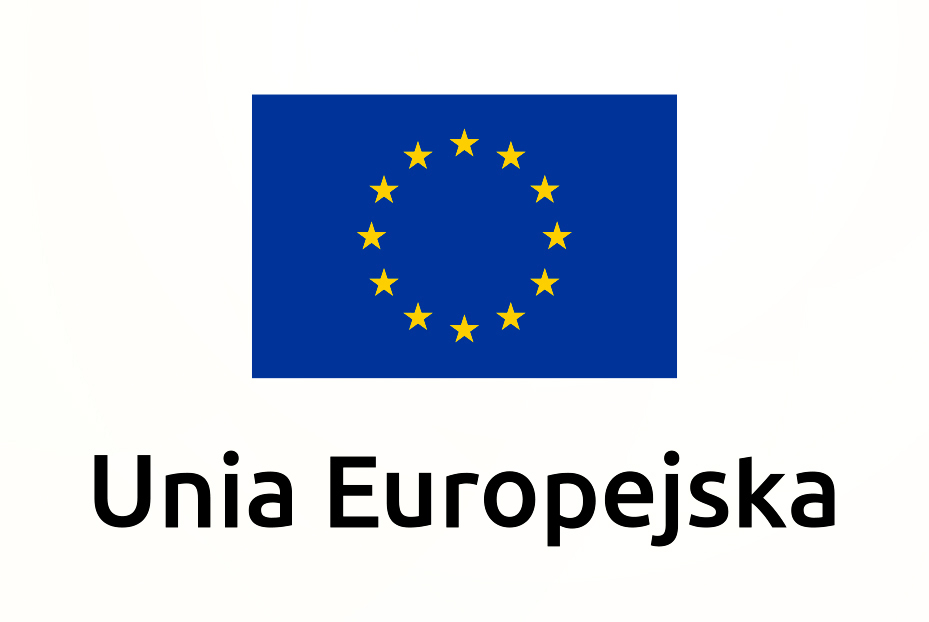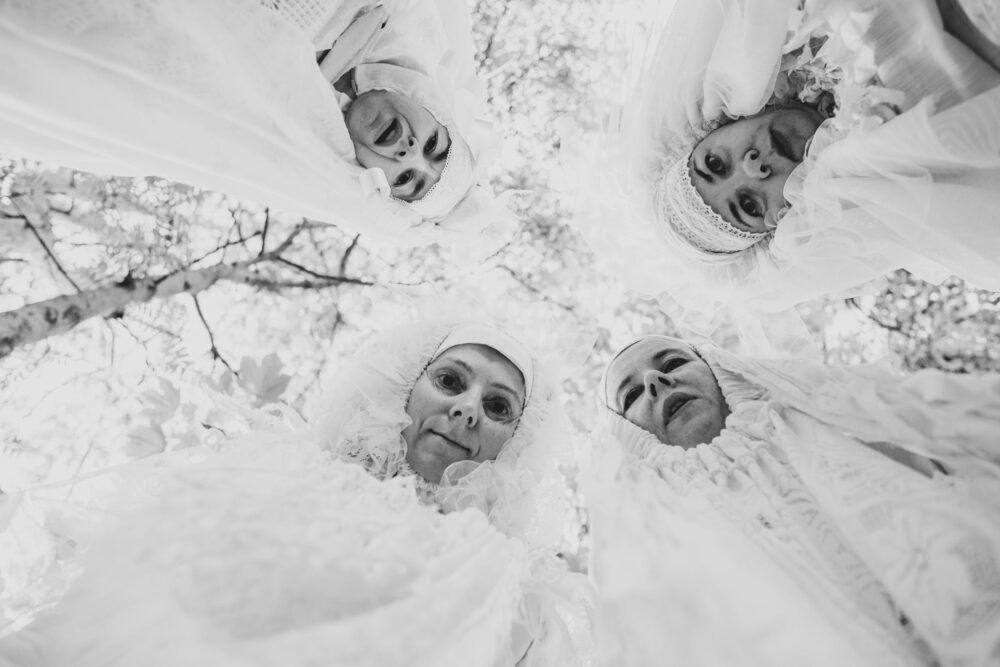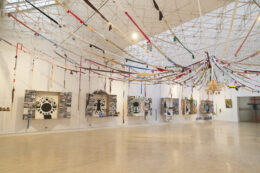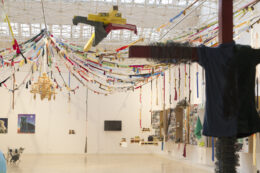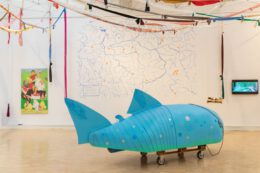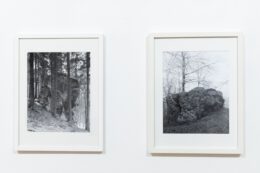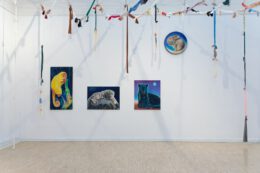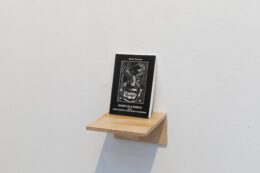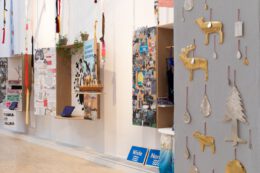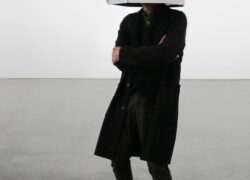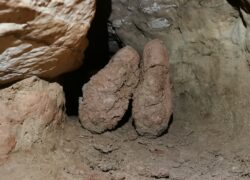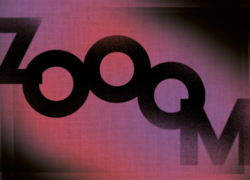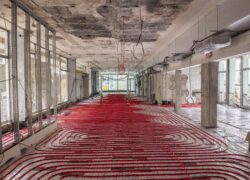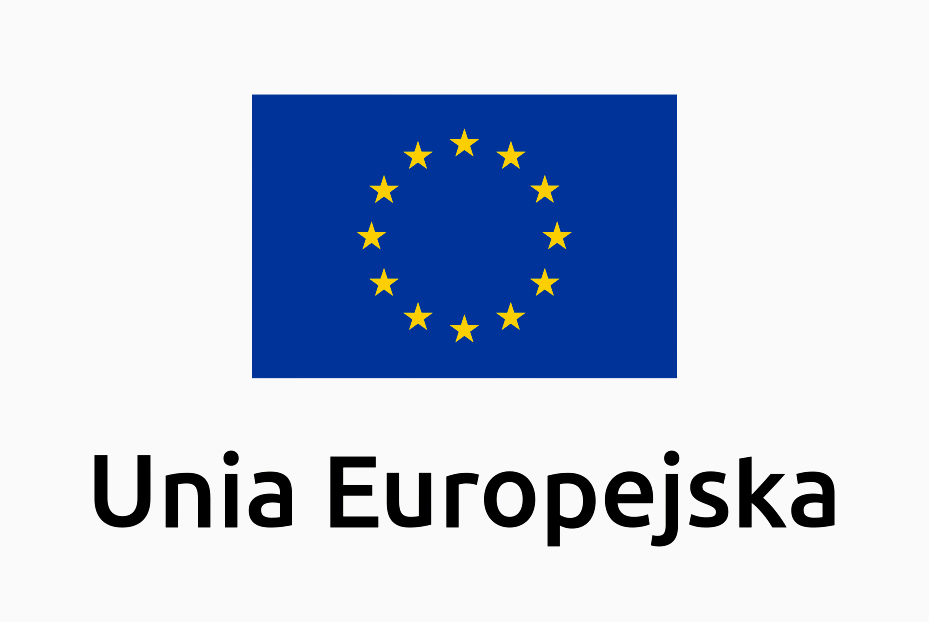Downloaddable maps:
Guide:
At the beginning there was a Spider Woman: Sumerian Uttu, according to Navajo – Na’ashjé’ii Asdzáá, Greek Arachne, in Hopi mythology – Kokyangwuti, a woman beyond time, representing everything that’s good, summoned when advice and care are needed, also known as a Spider Grandmother. A Spider Woman of Many Threads arose from an eternal need for justice, and from dust, her style is a combination of folk art from Kurpie and a mischievous drag. She spun her web in the upper display parts, embracing with her chelicerae the steel vault of the municipal gallery. She feeds on the warmth of the projectors mixed with liquefied CO2 exhaled by the heterotrophs, art lovers.
Donna Haraway, biologist and philosopher, in her book Staying with the Trouble: Making Kin in the Chthulucene, in which she confronts the consequences of climate change caused by humans, writes about the necessity of creating different, not only human, stories, which – spun using tender spider appendages – could spread like a web in many directions at once. These stories would be sympoietic, created collectively, in contrast to those autopoietic, self-reproducing ones. Stories fit for spider Chthulucene include hybrid-like chants, drawing parables and woven patterns, which do not divide and rule, but connect and speculate about the complex relations between living, transforming beings. These are healing stories, bringing comfort just like litter of decaying leaves, and stimulating the imagination like ripening compost.
The Magical Engagement exhibition, over which Spider Woman of Many Threads has spread her pedipalps, is a place where many threads are intertwined: activist, artistic, anti-fascist, animist, animalist, anti-competitive, magical, queer-feminist, and related to social and environmental justice. The event taking place as a part of the exhibition aim to break the “everyday capitalism spells”, and expose the severed ties between the social world and what is commonly considered as “natural”. The title refers to what has been repressed in the world driven by logic of capitalist Anthropocene, namely magic, ritual, memory of human and non-human ancestors, sympathy, relations. The opening of the exhibition will take place during the autumn solstice. Due to the pandemic reality, the live performances will be transferred to the net. It will be possible to see and listen to the SIORY collective and the Odłam Źdźbło choir [Break the Blade of Grass Choir] in the virtual space.
Visitors can explore the exhibition choosing one of the trails: activist, education, or the trail of magical engagement through art, which cross in some places and merge in others. There are guides for each trail. On the Activist Trail, symbolically divided into stops dedicated to water, air, earth, forest, animals, and movements, visitors can meet Siostry Rzeki [Sisters Rivers], Obóz dla Mierzei Wiślanej [Camp for the Vistula Spit], Flow, Polski Alarm Smogowy [Polish Smog Alert], Camp for Climate and Camp for Białowieża Forest, Inicjatywa Dzikie Karpaty [Wild Carpathians Initiative], Otwarte klatki [Open cages], kolektyw Kąpielisko [Kąpielisko Collective], anti-hunting movements, Wolę Być [I’d Rather Be], Extinction Rebellion, Młodzieżowy Strajk Klimatyczny [Fridays for Future], Fundacja Mare [Mare Foundation]…
Near the forest stop, located at the intersection of the trails, dedicated to the forest’s lichen and old trees, those still growing and those being irreversibly destroyed, we will meet Michał Chomiuk, a painter, activist, and storyteller. During his trips around Lublin and Podlasie regions he collects village tales about beelzebubs, rusalkas, bogeys, and women herbalists, passed from mouth to mouth. He preserves the tales and passes them further. Anna Błachno, a painter and activist, quit her job and started living in the Camp for Białowieża Forest, in order to commit fully to the activities undertaken there. She defies her work as “traditional veganist painting”. On the trail of magical engagement she recalls a she-bear and a visionary Amanita, and specifically their powers to remain aware, ethical, close to nature, especially one’s own, both in life and in art.
Ewa Ciepielewska is a painter, performer and keelwoman, travelling down the Vistula river on a wooden scow, year by year for 12 years, downstream and upstream, along its entire length (941 km). She is involved in the issue of preserving the river in its natural state. She is a proponent of restoring the unregulated state of the riverbanks and removing everything that blocks its flow. The artist is present at the Magical Engagement exhibition, not only in her human form, but also through her paintings showing the animal friends: Kuskus – an ancestor from the forest, Nousagi the Moon Bunny, Blue Panther and the Self-Propelled Snowy.
We were provided with 150 preserves made during the residence after the end of the world in Poznań’s DOMIE by Adelina Cimochowicz, an artist who chose a domestic and galactic kitchen for her studio.
Mandragora and silphium are the plant protagonists of the exhibition. The former appears in a stop motion animation by Małgorzata Gurowska, and the latter inspired Natala Biało to create a fountain. Mandragora is a creature whose shape resembles human figure, emphasizing the integrity of men and nature. In the dark it blooms with many colours and can have poisonous or healing effect. Thanks to its hybrid-like form and magical influence, mandragora has become fodder for myths, beliefs, ideas, fears, and guesses. Ripping it out of the earth carelessly can cause a thunderstorm. Natala Biało’s fountain is squirting with silphium juice – an emanation of female energy. In antiquity the raw material obtained from the plant was considered a panacea, antiseptic, laxative, contraceptive, and postcoital contraceptive. The plant also used to be considered an aphrodisiac. It was kept in vaults and trading was controlled by the state. According to the artist, silphium is one of the first commodified plants that became extinct as a result of human activity.
Yoanna Gwarek, an illustrator, takes us on a journey using cartoon stories from the Symbiosis series. On a small piece of paper she combines the small communities’ knowledge, an illustrator’s tenderness in examining fauna and flora, and knowledge gained on the road. The travelling book of illustrated stories is filled with gentle reflections on coexisting in a changing environment.
In Pasym, small northeastern town in Poland, Klaudia Paliwoda incarnates characters from Masurian legends, and, using the medium of a film, revives the memory of Smętek [Grief], Topielec [Floater], and rusalkas. Damien Brailly portrays Diabelskie Kamienie [Devil Stones] while travelling across Poland with a camera. The boulders, having witnessed the last glaciation, move the collective imagination in a country dominated by Catholic imagery. According to the legends, the presence of these stones is associated with the hellish forces at work.
Olga Anna Markowska, a Tri-City artist coming from Podlasie region, casts spells on time and space with a censer. By using emotive photographs and videos, she shows us that nature is not a capitalized artefact, but, most of all, home, a place for meetings, experiences, and feelings.
Jadwiga Anioła, a titled folk artist from Rogalinek, weaves ornamental spiders, harvest festival wreaths, and decorates Easter eggs. At the exhibition she will present a handmade spider as well as lead a workshop during which she will share her knowledge and craftsmanship. Daniel Rycharski, the author of Pomnik Chłopa [Monument of the Peasant] and considered as the initiator of the rural street art, will present four of his Strachy [Scares] – crosses of various religions, originally set up in a field. They served a double function, on the one hand, they reminded the rural community about their homosexual neighbours, on the other hand – they scared away prejudices and wild animals. Small tapestries, made by Joanna Borof from the Odłam Źdźbło group [Break the Blade of Grass] and presented nearby, recall the memory of forest fires in Siberia.
By choosing the Education Trail, the visitors can experience the exhibition not only as a presentation space, but also as a place of action. The participants in educational events bring their engagement to the gallery – sometimes intentionally leaving their trace, sometimes completely unknowingly sowing the seeds brought on the soles of their shoes. Young and old play scavenger hunt, prepare screenplays and storyboards – all this in order to participate actively and express what they think and how they see the institutional art space.
In the English language there is a saying “walk the talk” that means to live according to the principles one claims to uphold. At the Magical Engagement we connect trails and stories, practise art actively, activism in magic. What is social is no longer enough for us, so this is why we define engagement broadly, co-creating hybrids and collectives.
We recycle and upcycle the rituals out of oblivion on the cellular level. As representatives of the human race, humanus in Latin, we feel we are made of this earth, so we search for genealogy in more familiar humus rather than in a patriarchal violence of a family name. We want to lose our identity in a symbiotic, sentient and creative biomass, to become nameless children of compost.
___________________
*Chthulucene is a term used by Donna Haraway in her book Staying with the Trouble. Making Kin in the Chthulucene, Duke University Press 2016. The term was created by combining the Greek words chton ‘earth’ and kainos ‘new’ and means ‘the time of the earth; what is chronic’.
vernissage:
6 pm – performance of the choir Odłam Źdźbło [Grass Blade Fraction]
6.30 pm – performance of SIORY
Artistic Trail:
Jadwiga Anioła, Natala Biało, Anna Błachno, Joanna Borof, Damien Brailly, Michał Chomiuk, Ewa Ciepielewska, Adelina Cimochowicz, Małgorzata Gurowska, Yoanna Gwarek, Hanna Husberg, Cecylia Malik, Olga Anna Markowska, Odłam Źdźbło, Klaudia Paliwoda, Daniel Rycharski, Ola Winnicka / SIORY, Wspólnota międzygatunkowa +
Activist Trail:
BASTA! Inicjatywa na Rzecz Zwierząt, BRUK kolektyw akcyjno-reporterski, Ende Gelände, Extinction Rebellion, Flow, Fundacja Mare, Góra św. Anny, Grzybiarki Przeciwko Myśliwym, Inicjatywa Dzikie Karpaty, Karpacki Ruch Antyłowiecki, Klub Gaja, Lokalsi dla Puszczy, Limity jsme my, Młodzieżowy Strajk Klimatyczny, Nasze Jeże, Niech Żyją!, Obóz dla Klimatu, Obóz dla Mierzei Wiślanej, Obóz dla Puszczy, Occupy Chevron, Otwarte klatki, Polski Alarm Smogowy, Poznaniacy Przeciwko Myśliwym, Puszcza Bukowa, Ratujmy Imielin, Ratujmy Dolinę Rospudy, Projektowany Turnicki Park Narodowy, Rykowisko dla jeleni – nie dla myśliwych, Siostry Rzeki, Stowarzyszenie Eko-Przyjezierze, Stowarzyszenie Nasz Bóbr, Tama Tamie, Viva! Akcja dla zwierząt, W Obronie Polesia, Warszawski Ruch Antyłowiecki, Wolę Być, Zielona Fala
Education Trail:
Dziewczyny w Naturze: Sara Grolewska i Anka Gruszka, Magdalena Garczarczyk, Jan Kaczmarek, Robert Kalak, Tomasz Knioła, Michael Kurzwelly, Michał Michlewicz, Klaudia Lewczuk
Guides:
Paweł Błęcki, Kinga Mistrzak, Zofia nierodzińska, Anna Siekiera
Cooperation:
Marta Bączyk, Julia Dziewit, Matylda Konarska, Marika Opas, Aleksandra Polerowicz, Jarek Rusiński, Karol Wundziński
fot. Joanna Draszawka
